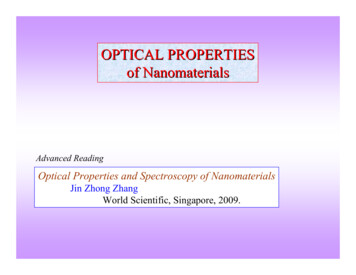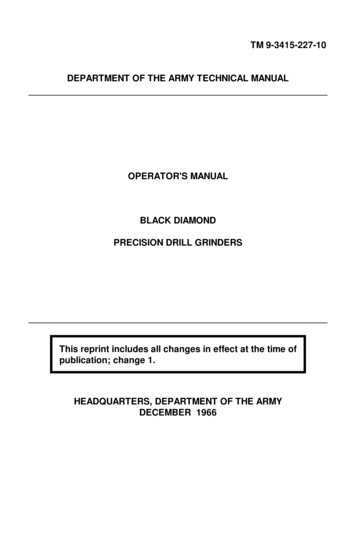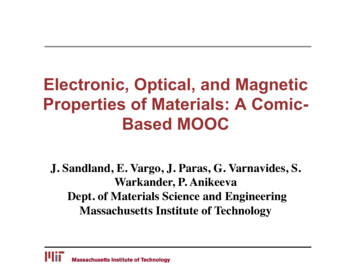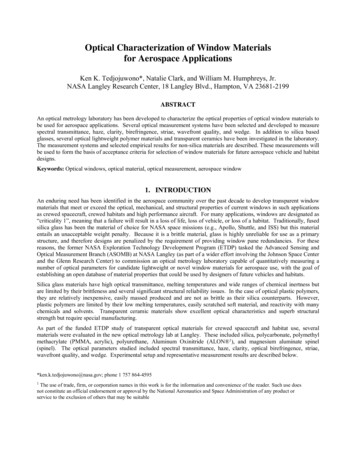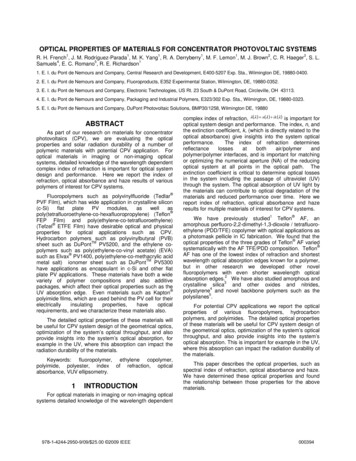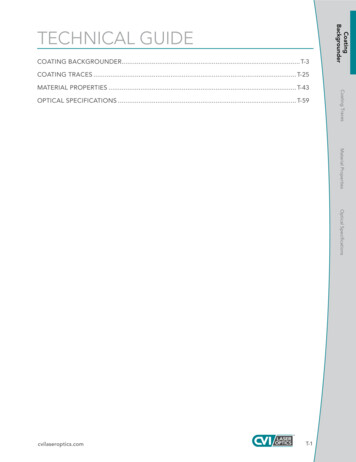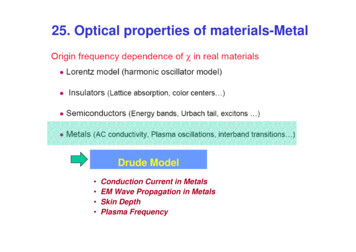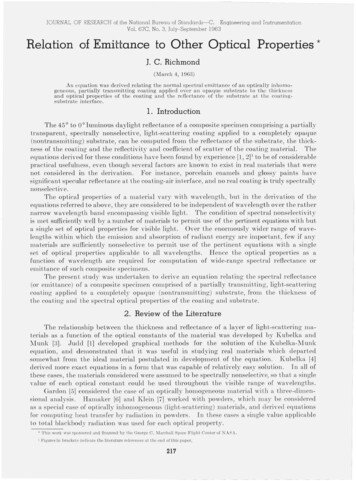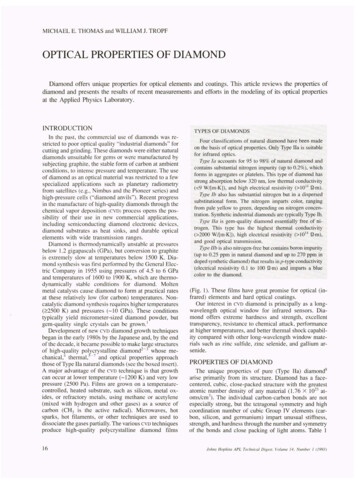
Transcription
MICHAEL E. THOMAS and WILLIAM J. TROPFOPTICAL PROPERTIES OF DIAMONDDiamond offers unique properties for optical elements and coatings. This article reviews the properties ofdiamond and presents the results of recent measurements and efforts in the modeling of its optical propertiesat the Applied Physics Laboratory.INTRODUCTIONIn the past, the commercial use of diamonds was restricted to poor optical quality "industrial diamonds" forcutting and grinding. These diamonds were either naturaldiamonds unsuitable for gems or were manufactured bysubjecting graphite, the stable form of carbon at ambientconditions, to intense pressure and temperature. The useof diamond as an optical material was restricted to a fewspecialized applications such as planetary radiometryfrom satellites (e.g., Nimbus and the Pioneer series) andhigh-pressure cells ("diamond anvils"). Recent progressin the manufacture of high-quality diamonds through thechemical vapor deposition (CVD) process opens the possibility of their use in new commercial applications,including semiconducting diamond electronic devices,diamond substrates as heat sinks, and durable opticalelements with wide transmission ranges.Diamond is thermodynamically unstable at pressuresbelow 1.2 gigapascals (GPa), but conversion to graphiteis extremely slow at temperatures below 1500 K. Diamond synthesis was first performed by the General Electric Company in 1955 using pressures of 4.5 to 6 GPaand temperatures of 1600 to 1900 K, which are thermodynamically stable conditions for diamond. Moltenmetal catalysts cause diamond to form at practical ratesat these relatively low (for carbon) temperatures. Noncatalytic diamond synthesis requires higher temperatures(2::2500 K) and pressures ( 10 GPa). These conditionstypically yield micrometer-sized diamond powder, butgem-quality single crystals can be grown. 1Development of new CVD diamond growth techniquesbegan in the early 1980s by the Japanese and, by the endof the decade, it became possible to make large structuresof high-quality polycrystalline diamond 2 - 3 whose mechanical,4 thermal,s -7 and optical properties approachthose of Type IIa natural diamonds (see the boxed insert).A major advantage of the CVD technique is that growthcan occur at lower temperature ( 1200 K) and very lowpressure (2500 Pa). Films are grown on a temperaturecontrolled, heated substrate, such as silicon, metal oxides, or refractory metals, using methane or acetylene(mixed with hydrogen and other gases) as a source ofcarbon (CH 3 is the active radical). Microwaves, hotsparks, hot filaments, or other techniques are used todissociate the gases partially. The various CVD techniquesproduce high-quality polycrystalline diamond films16TYPES OF DIAMONDSFour classifications of natural diamond have been madeon the basis of optical properties. Only Type IIa is suitablefor infrared optics.Type fa accounts for 95 to 98% of natural diamond andcontains substantial nitrogen impurity (up to 0.2%), whichforms in aggregates or platelets. This type of diamond hasstrong absorption below 320 nm, low thermal conductivity«9 W/[m·K]), and high electrical resistivity ( 10 14 n·m).Type fb also has substantial nitrogen but in a dispersedsubstitutional form. The nitrogen imparts color, rangingfrom pale yellow to green, depending on nitrogen concentration. Synthetic industrial diamonds are typically Type lb.Type IIa is gem-quality diamond essentially free of nitrogen. This type has the highest thermal conductivity( 2000 W/[m-K]), high electrical resistivity ( 10 14 n·m),and good optical transmission.Type lIb is also nitrogen-free but contains boron impurity(up to 0.25 ppm in natural diamond and up to 270 ppm indoped synthetic diamond) that results in p-type conductivity(electrical resistivity 0.1 to 100 n·m) and imparts a bluecolor to the diamond.(Fig. 1). These films have great promise for optical (infrared) elements and hard optical coatings.Our interest in CVD diamond is principally as a longwavelength optical window for infrared sensors. Diamond offers extreme hardness and strength, excellenttransparency, resistance to chemical attack, performanceat higher temperatures, and better thermal shock capability compared with other long-wavelength window materials such as zinc sulfide, zinc selenide, and gallium arsenide.PROPERTIES OF DIAMONDThe unique properties of pure (Type IIa) diamondSarise primarily from its structure. Diamond has a facecentered, cubic, close-packed structure with the greatestatomic number density of any material (1.76 X 1023 atoms/cm 3). The individual carbon--carbon bonds are notespecially strong, but the tetragonal symmetry and highcoordination number of cubic Group IV elements (carbon, silicon, and germanium) impart unusual stiffness,strength, and hardness through the number and symmetryof the bonds and close packing of light atoms. Table 1fohns Hopkins APL Technical Digest, Vo lume 14, Number 1 (1993)
Figure 1. Polycrystalline diamond windows made by Norton (DiamaTorr process). The square windows are 1 in. ona side and are polished ; the 4-in. circularwafer is unpolished. All samples areabout O.5-mm thick. The slight browncoloring is due to scatter. (Photographcourtesy of the Norton Diamond FilmCompany.)compares the hardness of diamond with other very hardmaterials. Diamond is the stiffest, strongest, and hardestknown material by at least a factor of 2. 8In addition to diamond 's unique mechanical properties, its thermal properties are also unusual. The strongnet bonding results in very low thermal expansion, highacoustic frequencies (and hence a very high Debye temperature of 2220 K), and low room-temperature heatcapacity. Even more remarkable is the exceptionally highroom-temperature thermal conductivity of diamond,which is more than five times that of metals such as silveror copper. This large thermal conductivity results in highresistance to thermal shock and thermal lensing.Table 2 compares the thermal conductivity of naturaldiamonds and CYD diamonds. Thermal conductivity is astrong function of impurities (especially nitrogen), defectconcentration, and isotopic content. Recent research onthe thermal conductivity of diamond shows a 50% increase when Be content is reduced to 0.1 % (from itsnatural 1.1 % abundance). 1,9 The thermal conductivity ofrecently developed thick polycrystalline diamond filmsapproaches that of a single crystal.Type IIa diamond is an excellent insulator and is resistant to chemical attack at ordinary temperatures. Diamonds heated above 875 K in the presence of oxygenor other catalytic agents form a graphite surface coating.Oxidation rates are 0.1 ILm/h at 600 C and 4 ILm/h at700 C. 12 In vacuum, significant conversion to graphite("graphitization") requires temperatures above 1800 K.Table 3 summarizes the properties of Type IIa diamond. Additional electronic, lattice, and transport properties are presented in standard handbooks.21OPTICAL PROPERTIES OF DIAMONDDiamond 's structure contributes to its unique opticalproperties , and its symmetry results in a pure covalentbonding, which accounts for the absence of infraredJohns Hopkins APL Technical Digest, Vo lume 14, Number J (/993)Table 1. Comparison of the Knoop hardness of diamond with thatof other hard materials. 8MaterialHardness(kg/rrun 2)DiamondBoron nitrideBoron carbideTungsten carbideSapphire90004500225021902000Table 2. Thermal conductivity of diamond.TypeNatural, IIa lO,11(or artificial)Natural,Ia 1,8,1O,1l(1.7 X lO2D/ cm3 N)Artificial,I ,9(99.9% 12C)CVD5-7Thermal conductivity(W/[m·KJ)2000 to 230080033201280 to 1700optical activity (no interaction of light with lattice vibrations) . To first order, diamond is transparent from its(indirect) electronic band gap (at 225 ILm) to the microwave region. Higher-order (multiphonon) lattice absorption processes cause significant absorption in the 2.5- to6-lLm region. Diamond has a Raman-active opticalmode22 (F2g or r (2S ) symmetry) at l332.4 cm- 1 (7.505ILm). A sharp Raman line indicates high-quality diamondand is used as a qualitative measure of CYD films, al17
M. E. Thomas and W. 1. Trap!Table 3. Room temperature properties of Type lIa diamond.PropertySpace groupLattice constant l3Density 14Elastic moduli IS,aEngineering moduli(random average)Poisson's ratioKnoop hardness 8Strength 8Melting point l6Debye temperature8Heat capacity 17Thermal expansion l 8Thermal conductivitylO,llBand gap,19Refractive index,20 n DAbbe number,b v DDielectric constant,2 EValueFd3m (O )0.356683 nm (Z 8)3.51525 g/cm3C II 1076.4 GPac 12 125.2 GPac44 577.4 GPaelastic: 1143 GPashear: 535 GPabulk: 442 GPa0.06919000 kg/mm 2 (500 g)2500 to 3000 MPa4100 K (P 12.5 GPa)2200K6.195 J/(mol·K)0.8 X 1O- 6/K2300 W/(m·K)5.50eV2.4172655.35.70(dE/dT)p 4.61 X 1O- s/K(dE/dP)T - 4.1 X 1O- 12/paNote: Z number of atoms in a unit cell.apressure and temperature dependence of the elastic constants can befound in H. J. McSkimin and P. Andreatch, "Elastic Moduli ofDiamond as a Function of Pressure and Temperature," 1. Appl. Phys.43, 2944-2948 (1972).bReference 8, p. 650, gives refractive indices nc 2.40990, nD 2.41726, nF 2.43554, and liD 55.3; source is unknown.though small grain size «'ARaman/2) reduces Raman intensity.23 Nondiamond character is usually revealed byRaman response 2 near 1550 cm- I .Visible PropertiesThe refractive index n of diamond 24 - 26 is given by theSellmeier equation,244.3356'A20.3306'A2n -1 'A2 (0.1060)2 'A2 (0.1750)2 'and infrared (e.g., at 7.8 /Lm) absorption, slight birefringence, and decreased thermal conductivity. 13 Metals suchas iron, aluminum, magnesium, and others are believedto cause green and brown coloration. Type IIa diamondsare clear with very low concentrations of nitrogen(::;20 ppm), boron, and other impurities.Optical scatter in single-crystal Type IIa diamonds isvery low. Polycrystalline CVD diamond has higher scattercaused by grain boundaries. Grain size and surface polishdetermine the scatter level in CVD diamond, and scattercan significantly limit transmission in the visible, ultraviolet, and near-infrared regions. 28 Scatter in CVD diamond is recognized by a gray or brown cast to the sampleand by uniformly decreasing transmission at high frequency.Ultraviolet PropertiesFigure 2 shows an APL measurement of the ultraviolettransmission of a Type IIa diamond window (0.5-mmthickness) in the region near its band gap. The extinctioncoefficient also shown in Figure 2 is derived using theindex of refraction from Equation 1 and solving theresulting quadratic equation that relates the absorptioncoefficient to transmittance. The exponential increase in .absorption with frequency (or energy) near the band gap(5.5 eV) is known as the Urbach edge. The ultravioletabsorption coefficient (3 can be modeled as a function ofenergy E (in e V) and temperature T by the equation(3(E, T) (30 exp[a(T)(E -(2)where kB is Boltzmann's constant.Using the room-temperature absorption data of Figure2 and assuming a value of 6.5 eV (the direct band gap)for the constant Eo of Equation 2, gives the followingparameters for the Urbach edge model: (30 4.23 X 1011cm- \ a(300 K) 0.585. Temperature-dependent absorption measurements are needed to derive the temperaturedependence of aCT) and give the precise location of Eo.1202Urbach edge model(1)where the wavelength 'A is in micrometers. This equationcan be used to determine reflectivity from 0.225 /Lm (inthe ultraviolet) through the infrared. Note that diamondhas a high index of refraction with high dispersion in thevisible (which is enhanced by the cut of diamond gems)and essentially no dispersion in the infrared. 2sThe temperature derivative of the refractive index(thermo-optic coefficient) is available for visible wavelengths27 and at low frequency20 and is given in Table 4.Color in diamond comes from impurities. Nitrogen andboron are the principal impurities and impart yellow andblue coloring, respectively, when they are in sufficientconcentration. The nitrogen impurity can take severalforms: single-substitution as well as distinct types ofprecipitates ("platelets"). Nitrogen causes an increasedlattice constant, increased ultraviolet (e.g., at 0.3065 /Lm)18Eo)],kBT100 'I100E 8080uc.;lE(J)cCll. c w0.250.30Wavelength (/km)Figure 2. Our measurement of the ultraviolet transmission andabsorption coefficient of Type lIa diamond (0.5-mm thick) at roomtemperature. The gradually rising absorption (weak absorption tail)becomes rapid (Urbach absorption edge) atthe band gap (225 nm).Both types of absorption can be described by exponential functions.f ohns Hopkins APL Technical Digest, Volume 14, Number 1 (1 993)
Optical Properties of DiamondTable 4. Temperature derivative of the refractive index n of diamond.Wavelength (Jlm)0.43580.54610.5893LongRefractive index2.44992.42372.4 173(2.39)(dn/dT) X 1O-6jK(l/n)dn/dT X e featureless extinction between 0.225 and 0.35 j.tmis believed to be caused by absorption rather than scatter. 8This absorption is also approximately exponential withenergy and can be modeled as(3(E) 0.28 exp(0.45E) ,(3)where E is again in e V and the absorption coefficient isin cm - I. This equation is in the usual fonn of the temperature-independent "weak-tail" absorption observed incrystalline and semiconductor materialInfrared Properties: MeasurementsOur major interest in the optical propel1ies of diamondis the significant multi phonon absorption region (see theboxed insert) that lies between 2.5 and 6 j.tm. This absorption limits the usefulne of diamond windows in themiddle infrared region frequently u ed by infrared sensors. Measurements were made of natural, single-crystalType IIa diamonds provided to us by the U.S. ArmyStrategic Defense Command (Figure 3). Figure 4 showsthe room temperature absorption coefficient of diamondderived from transmission measurements. This figureclearly shows two- , three- and four-phonon absorption.We believe Figure 4 documents the first observation offour-phonon absorption in diamond. The triangle marksabsorption measured by laser calorimetry,29 which is usedto calibrate the spectral transmittance. Also shown are ourmodels of the absorption coefficient, which are discussedin this section.Absorption at the infrared edge of insulators is causedprincipally by anhannonic tenns in the lattice potential.These higher harmonics of the lattice resonances areinfrared active even if the fundamental vibrations are not.This phenomenon is called multi phonon absorption because the light is absorbed by exciting multiple (two ormore) lattice phonons (vibrations). For infrared absorption, each succe sively higher multiple of the fundamental frequency is weaker (and broader), leading to decreasing absorption beyond the highest fundamental absorption frequency (the maximum transverse optical phononfrequency). The resulting infrared absorption edge ofmost materials (especially highly ionic insulators) ischaracterized by an absorption coefficient that decreasesexponentially with frequency. At about three times thehighest transverse optical frequency, the absorption coefficient becomes reasonably small, and a material witha thickness from 1 to 10 mm is basically transparent.Group IV materials with the diamond structure areunique in that no infrared-active fundamental lattice vibrations are present: to first order, the material is transparent throughout the infrared. Higher-order (mulJohns Hopkins APL Technical Digest. Vo lume 14, Number 1 (1993)Figure 3. Natural Type lIa diamonds supplied by the U.S. ArmyStrategic Defense Command for characterization . Sample F-805(left) is 9.5-mm long , has a clear aperture of 4 mm, and weighs0.150 g. Sample F-806 , used for the measurements reported here,is 1O-mm square , 0.5-mm thick, and weighs 0.166 g. Sample F-807is 13.8-mm long, 0.32-mm thick, weighs 0.104 g, and has a smallcrack (dark area) at the bottom. (One carat equals 0.2 g.)tiphonon) absorptions are, however, optically active and,in diamond, cause considerable absorption in the 2.5- to6-j.tm (1700- to 4000-cm- 1) spectral region.Figure 5 shows absorption in the 10-j.tm region. Thismeasurement was made using a longer integration timethan was used for Figure 4. The longer integration timeimproves the signal-to-noise ratio at the expense of absolute accuracy. These data have been corrected usingwell-established features from short integration timemeasurements. The absorption features seen are real; theyarise from the intrinsic vibrational modes of diamondactivated by defects and impurities and possibly by infrared bands associated with defect centers and substitutional impurities. Many of these features can be correlated with zone-edge critical-point phonon vibrations 30 vi ible in Figure 5. The triangle marks absorption measuredby laser calorimetry (also shown in Fig. 4).We have also measured the temperature dependence ofthe infrared absorption coefficient. As temperature increases, the multiphonon absorption becomes strongerand reaches the classical limit of T 1/-1 at high temperature, where n (""vjvRaman) is the number of phonons contributing to absorption. At low temperature, absorptionhas no temperature dependence, since only transitionsfrom the ground state occur. Once the temperature issufficiently high (i.e. , approaching the Debye temperature), transitions that originate from excited states become important, and the classical temperature depen19
M. E. Thomas and W. 1. Trop!100 .--------- ----------.--------- ----------,----------,L(X) TA(X)Figure 4. Our measurement of theinfrared absorption coefficient of TypelIa diamond at room temperature. Thetwo-, three- , and four-phonon absorptions in the 1000- to 5000-cm - 1 (2- to1O-lLm) spectral region are clearly seen.Some two-phonon spectral featuresare labeled with their spectroscopicidentification (e.g. , L[x] is the longitudinal frequency at the X critical point) .30These features , predicted by theory,are observed at the expected locations. Also shown are the optical andacoustic components of our multiphonon absorption model and a lasercalorimetry measurement (triangle).2910/"IE Optical 2-phononabsorption modelICQ)20(r)(2-Raman)'(3;;::Q)0Natural diamond/(298 K)Composite 2-phononuc0li(;(/).0«0.1 0.01Optical 3-phononabsorptionL - L o30002000100040005000Wave number (cm- 1)0.25 ,----.---- - - , - - - - - - ,- - - - , -- -.------,ABSORPTION IN SOLIDSThe absorption of light in insulating solids arises fromtwo principal sources: electronic transitions and latticevibrations. Electronic absorption typically occurs in theultraviolet, whereas absorption by lattice vibrational modesoccurs in the infrared.A phonon is a quantum of lattice vibration (elastic)energy (as the photon is the quantum of electromagneticenergy). Phonons are classified as either acoustic (compression waves) or optic. Optic phonons that are infrared activeabsorb light through an interaction between the electric fieldof the light and the dipole moment of the material. Diamondis a symmetric, covalent material with no dipole momentand therefore has no infrared active phonons.Weak phonon absorption can be induced in solids by veryintense light (Raman -active phonons) or by combinationsof phonons (multiphonons) that create weak dipole moments. Diamond has one Raman mode (observed at 1332.4cm - I) and one acoustic mode.In crystals, frequencies of these modes change withpropagation direction, creating many two-phonon absorption features. These multiphonon absorption bands areweak compared with fundamental (one-phonon) absorptionand occur at frequencies that are harmonics of the fundamental frequency.In diamond, which has no infrared-active one-phononabsorption, multiphonon effects dominate infrared absorption.dence is observed. Figure 6 shows measured absorptioncoefficients at room temperature and at 771 K. Table 5summarizes the band-integrated results for several temperatures. These absorption data are shown in Figure 7compared with the classical temperature dependence.Note that the higher multiphonon contributions growmore rapidly with temperature as expected but have notreached a temperature where the classical limit applies.20f' 0.20E C. 0.15;;::Q)ou§ 0.10'a(;(/) 0.05OL--- -- ------l----- ---- ---- 6007008009001000Wave number (cm-111001200)FigureS. Room-temperature absorption in the 1O-lLm (1 000 cm - 1)region . A longer integration time was used to reduce the noise seenin Figure 4. The various absorption features are caused by fundamental vibrational modes of diamond that would normally not beobserved unless activated by defects and impurities. Some ofthese zone-edge critical-point vibrations are identified by theirspectroscopic notation , as in Fig. 4. 30 Also shown is the lasercalorimetry measurement (triangle) from Figure 4. 29Another noticeable feature of the higher temperaturedata is the shift of the absorption bands to lower frequency. This red shift is caused by the increased populationof higher energy levels coupled with the lower energyseparation of these higher levels.Chemical vapor deposition diamond has additional absorption features in the one-phonon region (500 to 1332cm- I ) caused by greater concentration defects and impurities. 3o The optical (infrared) quality of diamond can beassessed by directly measuring absorption. As CVD techniques have improved, infrared absorption in CVD diamonds has approached that of natural diamonds.John s Hopkins APL Technical Digest, Volume 14, Nu mber 1 (/993)
Optical Properties of --.--------- "'IE10 Figure 6. Temperature dependenceof the infrared absorption coefficient.The blue curve shows room temperature absorption , and the green curveshows the absorption coefficient at771 K. Note the red shift of the absorption spectra at high temperature andthe more rapid growth of the strengthofthe higher-order multiphonon bands.CQ)'u;;::::Q)0uc0'a0(/J.0 C0.1Natural diamond(298 K)0.01L - -U L o10002000Wave number300040005000(cm- d Properties: ModelsWe have successfully developed a semiempirical,quantum mechanical model of (sum-band) multiphononabsorption based on the Morse interatomic potential anda modified Gaussian function for the phonon density ofstates. 31 Use of the Morse potential leads to an exactsolution to the Schrodinger equation that includes anharmonic effects to all orders. The central limit theoremensures that the phonon density of states becomes Gaussian for high-order multiphonon absorption. Our modelcontains parameters derived from room temperaturemeasurements of absorption, it is computationally efficient, and it has been successfully applied to many ionicsubstances. 32 Surprisingly, this model can also be appliedto diamond. 33 Figure 4 shows the result.Our multiphonon model is based on only six parameters: a dissociation energy (the depth of the Morsepotential well), the maximum longitudinal opticalphonon frequency, an absorption scaling constant, andthree parameters that describe the phonon density ofstates. No optically-active modes are present in diamond;therefore, no maximum longitudinal frequency exists forthe model. Instead, we use the Raman frequency and notethe sharp decrease in absorption at two, three, and fourtimes the Raman frequency (Fig. 4). Our multiphononoptical model cannot accurately reproduce the spectralcontent of the two-phonon region, which consists ofmany different two-phonon interactions,3o because diamond does not conform to the near-Gaussian density ofstates assumption that becomes accurate only when several phonons interact (typically, three or more phonons).Some of the two-phonon spectral features are labeled inFigure 4.Diamond absorptance near 10 JLm (1000 cm -1) is ofparticular interest because many infrared sensors operateat this wavelength. Evidence indicates that the absorptionedge bounding this region is caused by two-phononacoustic-acoustic interactions. Normally, pure acousticmultiphonon absorption is not measurable because it isobscured by strong one-phonon absorption. Diamond hasJohns Hopkins APL Technical Digest, Volume 14, Number 1 (1993 )Spectral region:T1"'IE--1950-2044 CQ) 10'u- 1660-2660 JcoCD 00500Temperature (K)1000Figure 7. Temperature dependence of band-averaged infraredabsorption coefficient for two-, three-, and four-phonon regions.Dashed curves show the p -l absorption dependence predicted byclassical theory for high temperatures (n is the order of the phononcontribution). Lower signal-to-noise ratio accounts forthe irregularity of the four-phonon result.very high acoustic frequencies because of its strongbonds, and the lack of fundamental absorption unmasksthe pure acoustic contribution. We model this contributionby assuming a Debye acoustic single-phonon distributionPl(W) of the form21
M. E. Thomas and W. 1. Trap!Table 5. Band-averaged , temperature-dependent absorption coefficient (in cm - 1) of natural diamond fromtransmission measurements.Temperature wo-phononSpectral bandcm- 7718.4816.975.55CONCLUSION(4a)where P is the density of states distribution function foracoustic modes, W is the angular frequency, and W max isfound by fitting to data. Higher-order (nth) acousticphonon distributions are computed by convolving thisdistribution with the n - 1 phonon distribution:rn XWm axPn(w) JPn-l (w')p(w - w')dw' .o(4b)For the two-phonon distribution, the result is9- 6-W max?w- 3-3 [w m ax{4-(w - wmax )43]W1--[wmax -(w-w max ) ] -[w max -(w-w max )255}]REFERENCES(4c)Using the parameter Wmax 1183 cm- I and an absorptionscaling constant of 487.5 cm - 2 gives the result shown inFigure 4. This second (acoustic) contribution, althoughweak, is important because it lies in the 8- to 10-JLffiatmospheric window frequently used by infrared sensors.Note that our selected value of 1183 cm - I is consistentwith both the computed Debye frequency as well as thehighest reported acoustic frequency. 3D Using a high-temperature value of 1860 K for the Debye temperature ofdiamond 8 gives a Debye frequency of 1290 cm - I. Thehighest observed acoustic frequency for diamond rangesfrom 1185 to 1191 cm -I (longitudinal acoustic frequencyat the X critical point LA[X]), consistent with the valuethat best fits the data.22We measured the room temperature ultraviolet transmission of diamond and derived the absorption coefficient. Ultraviolet absorption at the band gap was characterized as an Urbach absorption edge model. We havealso measured and characterized the weak absorption tailfor this particular sample. Additionally, the room- andelevated-temperature transmission of diamond in the infrared has been measured. For the first time, four-phononabsorption was observed, and the temperature dependence of the two-, three-, and four-phonon absorptionwas determined. We have demonstrated that the generalinfrared absorption features of diamond can be duplicatedby our multiphonon model, which was originally developed for highly ionic materials. Acoustic contributions tomultiphonon absorption, which are important in the 10JLm spectral region, can also be modeled.1Strong, H. M. , and Wentorf, R. H. , " Growth of Large, High-QuaJity DiamondCrystals at General Electric," Am. 1. Phys. 59 1005-1008 ( 1991 ).2 Yarbrough, W. A. , and Messier, R., "Current Issues and Problems in theChemical Vapor Deposition of Diamond," Science 247, 688-696 (1990).3Geis, M. W., and Angus, 1. c., " Diamond Film Semiconductors," ScientificAmerican , 84-89 (Oct 1992).4Jiang, X. , Harzer, J. V., Hillebrands, B. , Wild, Ch. , and Koidl, P., "BrillouinLight Scattering on Chemical-Vapor-Deposited Pol ycrystalline Diamond:Evaluation of the Elastic Moduli ," Appl. Phys. Lett . 59, 1055- 1057 (1991).5Morelli , D. T. , Hartnett, T. M., and Robin son, C. I. , "Phonon-DefectScattering in High Thermal Conductivity Diamond Films," Appl. Phys. Lett.59, 2112-2114 (1991 ).6Lu . G ., and Swann, W. T., " Mea urement of Thermal Diffusivity ofPolycrystalline Diamond Film by the Converging Thermal Wave Technique,"App/. Phys. Lett. 59, 1556-1558 (1991 ).7 Graeber, J. E., Jin, S., Kammlott, G . W. , Herb, J . A. , and Gardner, C. F.," Unusually High Thermal Conductivity in Diamond Films," Appl. Phys. Lett.60, 1576-1578 (1992 ).8Field , J. E. , The Properties of Diamond, Academic Press, San Diego ( 1979).9 Anthony, T . R. , Banholzer, W. F., Fleischer, J . F. , Wei , L. , Kuo, P. K. , et aJ .,"Thermal Diffusivity of IsotopicaJl y Enriched 12C Diamond," Phys. Rev. B42, 1104-1111 (1990).1OBerman, R. , Foster, E . L. , and Ziman, J. M., "The Thermal Conductivity ofDielectric Crystals: The Effect of Isotopes," Proc. Royal Soc. (London) A237,344-354 ( 1956).II Berman , R., and Martinez, M., "The ThermaJ Conducti vity of Diamonds,"Diamond Research 1976 (Suppl. to Ind. Diamond Rev. ), 7- 13 ( 1976).f ohns Hopkins APL Technical Digest. Vo lume 14 , Number I (1 993)
Optical Properties of Diamond1210hnson, C. E., Weimer, W. A. , and Harris, D. c., "Characterization ofDiamond Films by Thermogravimetric Analysis and Infrared Spectroscopy,"Mat . Res. Bull. 24, 1127- 1134 ( 1989).13 Kaiser, W., and Bond, W. L., " Nitrogen , a Major Impurity in CommonType I Diamond," Phys. Rev. 115, 857-863 (1959).14Mykolajewycz, R. , Kalnajs, 1., and Smakula, A. , " High-Precision DensityDetermination of atural Diamonds," J . Appl. Phys. 35, 1773-1778 (1964).15Grimsditc
OPTICAL PROPERTIES OF DIAMOND Diamond offers unique properties for optical elements and coatings. This article reviews the properties of . materials. Diamond is the stiffest, stronges


